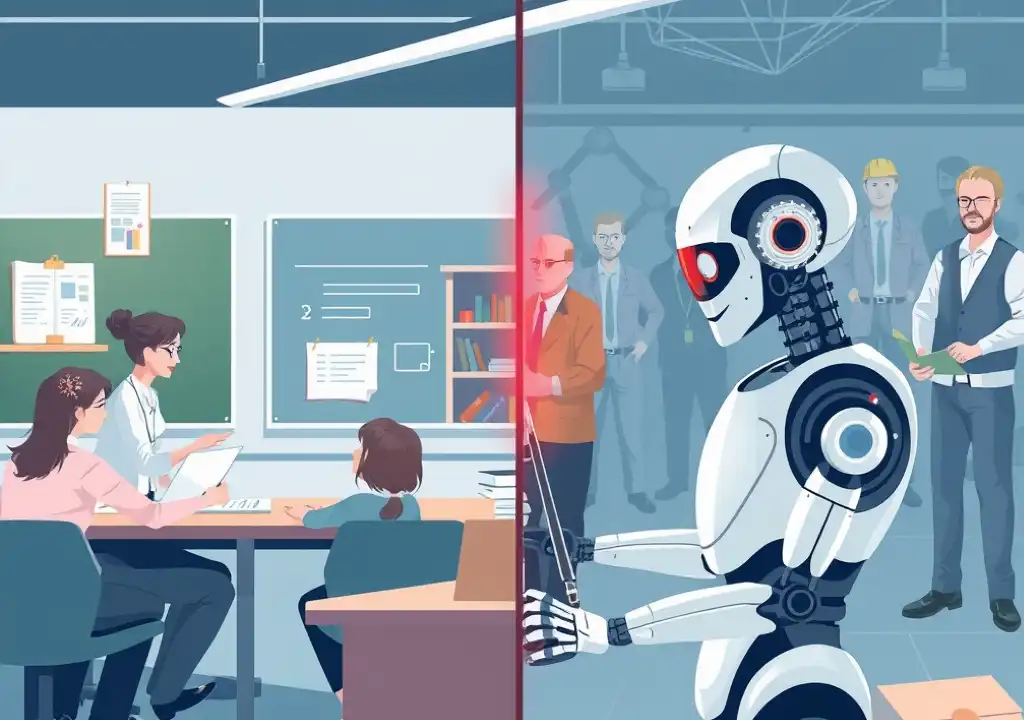The latest wave of AI technology is poised to disrupt the workforce. Teachers may feel the most impact, but it could ultimately create more job opportunities.
Since its November 30 debut, ChatGPT has taken the artificial intelligence world by storm. In just four months, it has demonstrated impressive capabilities, from passing the bar and medical licensing exams in the U.S. to writing emails, composing songs, building apps, and much more.
What sets ChatGPT apart is that it is freely available to the public, unlocking possibilities previously thought unattainable by AI—despite some criticism over the lack of transparency in its training process. OpenAI, the company behind ChatGPT and backed by Microsoft, saw the app become the fastest-growing consumer app worldwide, reaching 100 million users by January.
This success has led Microsoft to integrate ChatGPT’s technology into its Bing search engine and Edge browser, while Google launched its own AI app, Bard, in February. Recently, OpenAI introduced GPT-4, an upgraded version that can analyze images, process larger texts, and even create websites from hand-drawn sketches or recreate games in seconds.
Companies are eager to incorporate ChatGPT’s technology into products across various industries, from customer service to financial analysis. However, as the International Labour Organization predicts 208 million unemployed people in 2023, the question arises: Will this AI revolution lead to mass unemployment, and which jobs could be affected? The answer is complex: while ChatGPT and other AI platforms may replace some routine jobs, the technology is likely to enhance productivity and support human workers rather than replace them entirely.
AI in the Classroom: Teachers on the Frontline
ChatGPT and other similar AI platforms are different from previous AI systems because they use GPT (Generative Pre-trained Transformer), which employs deep learning to perform tasks like generating text, answering questions, and mimicking human language more effectively than ever before.
The impact on the workforce will be profound, especially in sectors that rely heavily on language tasks, such as education. A study by researchers at Princeton, the University of Pennsylvania, and New York University found that teachers, particularly those in post-secondary education who specialize in languages, literature, history, law, and the humanities, would be most vulnerable to AI disruption.
However, the idea that AI will entirely replace teaching jobs is unlikely. While AI could assist teachers with tasks like catching plagiarism, creating teaching materials, and even automating some administrative functions, it won’t be able to handle the full scope of a teacher’s responsibilities. ChatGPT still has limitations, such as making basic errors in math or logic, which prevent it from fully replacing human educators.
Routine Jobs May Face Displacement
Routine jobs, particularly those in fields like telemarketing, language translation, and phone support, are more vulnerable to being displaced by AI. But even as jobs are displaced, AI could also create new roles. The World Economic Forum forecasts that AI may eliminate 85 million jobs globally by 2025, but it could also generate 97 million new jobs in areas like machine learning, digital marketing, and cybersecurity.
Although AI will likely change many aspects of the workplace, it could enhance productivity rather than cause widespread job loss. For instance, research from MIT suggests that ChatGPT significantly boosted productivity for professionals engaged in mid-level writing tasks. This could narrow the gap between less skilled and more skilled workers, especially in writing-intensive professions.
AI’s Impact on Various Sectors
Despite the potential for disruption, AI’s ability to replace human workers may be limited to more routine tasks. High-skilled professionals, such as lawyers and pharmacists, will continue to require human judgment and expertise. For example, while ChatGPT could assist in drafting legal documents, it cannot replace the personal touch needed in courtrooms or provide the judgment required in medical practices.
The key to successfully integrating AI into the workforce is balancing human labor with technology. Companies, like Tesla, have acknowledged that excessive automation can be counterproductive, as human labor is still needed to complement technology.
Manual Labor Remains Safe from AI
Jobs involving physical labor, such as brick masons, carpenters, and textile workers, will likely remain unaffected by AI. High-skilled roles are also less likely to face disruption, as these positions require judgment, creativity, and hands-on expertise that AI cannot replicate. In contrast, middle-skill jobs—where tasks are more routine and knowledge-based—are more susceptible to automation.
Workers in affected industries can also adapt by upgrading their skills to work alongside AI tools. Understanding and leveraging AI like ChatGPT can help workers remain competitive in an evolving job market.
The Future of Work: A New Balance
Ultimately, the success or failure of AI technology like ChatGPT will depend on how consumers and businesses adapt to it. Although some studies show that consumers prefer interacting with human beings for services requiring nuanced understanding, AI’s speed, round-the-clock availability, and objectivity are significant advantages.
While AI is disrupting the labor market, it does not spell the end of work. Technological advancements throughout history, from the steam engine to computers, have changed the nature of work rather than eliminating it. As AI continues to develop, the workplace will evolve—but humans will remain an essential part of the equation.

